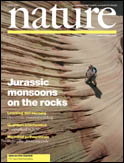
Annual Monsoon Rains Recorded by Jurassic Dunes
On the Cover: Pangaea, the largest landmass in the Earth’s history, was nearly bisected by the Equator during the late Palaeozoic and early Mesozoic eras. Modelling experiments and stratigraphic studies have suggested that the supercontinent generated a monsoonal atmospheric circulation that led to extreme seasonality, but direct evidence for annual rainfall periodicity has been lacking. In the Mesozoic era, about 190 million years ago, thick deposits of wind-blown sand accumulated in dunes of a vast, low-latitude desert at Pangaea’s western margin, now situated in the southwestern USA. Twenty-four slumps, which were generated by heavy rainfall, appear within one interval representing 36 years of dune migration, providing a prehistoric record of yearly rain events.
David B. Loope, Clinton M. Rowe & R. Matthew Joeckel. July 2001. Annual monsoon rains recorded by Jurassic dunes. Nature 412 (6842).
David Loope, Clinton Rowe and Matt Joeckel are all professors of earth and atmospheric sciences.





